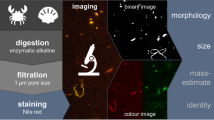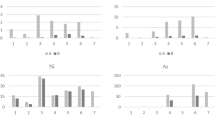Abstract
The goal of this paper is to explore the relationship between the inorganic elemental fingerprint and the geographical origin identification of Meretricis concha, which is a commonly used marine traditional Chinese medicine (TCM) for the treatment of asthma and scald burns. For that, the inorganic elemental contents of Meretricis concha from five sampling points in Jiaozhou Bay have been determined by means of inductively coupled plasma optical emission spectrometry, and the comparative investigations based on the contents of 14 inorganic elements (Al, As, Cd, Co, Cr, Cu, Fe, Hg, Mn, Mo, Ni, Pb, Se and Zn) of the samples from Jiaozhou Bay and the previous reported Rushan Bay were performed. It has been found that the samples from the two bays are approximately classified into two kinds using hierarchical cluster analysis, and a four-factor model based on principle component analysis could explain approximately 75% of the detection data, also linear discriminant analysis can be used to develop a prediction model to distinguish the samples from Jiaozhou Bay and Rushan Bay with accuracy of about 93%. The results of the present investigation suggested that the inorganic elemental fingerprint based on the combination of the measured elemental content and chemometric analysis is a promising approach for verifying the geographical origin of Meretricis concha, and this strategy should be valuable for the authenticity discrimination of some marine TCM.
Similar content being viewed by others
References
Chen, Y. X., Yu, M. G., and Xu, J., 2009. Differentiation of eight tea (Camellia sinensis) cultivars in China by elemental fingerprint of their leaves. Journal of the Science of Food and Agriculture, 89(14): 2350–2355.
Jolliffe, I., 2004. Principal Component Analysis. Springer, New York, 150–165.
Lavilla, I., Costas, M., San Miguel, P., Millos, J., and Bendicho, C., 2009. Elemental fingerprinting of tumorous and adjacent non-tumorous tissues from patients with colorectal cancer using ICP-MS, ICP-OES and chemometric analysis. Biometals, 22(6): 863–875.
Li, N., Wang, Y., and Xu, K., 2006. Fast discrimination of traditional Chinese medicine according to geographical origins with FTIR spectroscopy and advanced pattern recognition techniques. Optics Express, 14(17): 7630–7635.
Li, W. F., Jiang, J. G., and Chen, J., 2008. Chinese medicine and its modernization demands. Archives of Medical Research, 39(2): 246–251.
Lin, H. M., and Zhang, W. L., 2005. The similarities and differences between principal component analysis and factor analysis of SPSS software. Statistical Research, 3: 65–69 (in Chinese with English abstract).
Marengo, E., and Aceto, M., 2003. Statistical investigation of the differences in the distribution of metals in Nebbiolo-based wines. Food Chemistry, 81(4): 621–630.
National Pharmacopoeia Committee, 2010. Chinese Pharmacopoeia. China Medical Science Press, Beijing, 916–918 (in Chinese).
Pearson, K., 1901. On lines and planes of closest fit to systems of points in space. Philosophical Magazine, 2(11): 559–572.
Qiu, Y., Lu, X., Pang, T., Zhu, S., Kong, H., and Xu, G., 2007. Study of traditional Chinese medicine volatile oils from different geographical origins by comprehensive two-dimensional gas chromatography-time-of-flight mass spectrometry (GC×GC-TOFMS) in combination with multivariate analysis. Journal of Pharmaceutical and Biomedical Analysis, 43(5): 1721–1727.
Tan, X. M., Wang, X. Y., Zhang, M. M., Zhang, W. X., and Wang, W. F., 2011. Determination of microelement of testacean traditional Chinese medicines. Chinese Journal of Experimental Traditional Medical Formulae, 17(1): 61–63 (in Chinese with English abstract).
Wang, C. F., Duo, M. J., Chang, E. E., and Yang, J. Y., 1996. Essential and toxic trace elements in the Chinese medicine. Journal of Radioanalytical and Nuclear Chemistry, 211(2): 333–347.
Wang, X., Zhuang, Z., Sun, D., Hong, J., Wu, X., Lee, F. S. C., Yang, M. S., and Leung, H. W., 1999. Trace metals in traditional chinese medicine: A preliminary study using ICP-MS for metal determination and as speciation. Atomic Spectroscopy, 20(5): 86–91.
Ward, J. H., 1963. Hierarchical grouping to optimize an objective function. Journal of the American Statistical Association, 58(301): 236–244.
Wu, X., Zheng, K., Zhao, F. J., Zheng, Y. J., and Li, Y. T., 2014. Construction of inorganic elemental fingerprint and multivariate statistical analysis of marine traditional Chinese medicine Meretricis concha from Rushan Bay. Journal of Ocean University of China, 13(4): 712–716.
Xie, P., Chen, S., Liang, Y. Z., Wang, X., Tian, R., and Upton, R., 2006. Chromatographic fingerprint analysis ? A rational approach for quality assessment of traditional Chinese herbal medicine. Journal of Chromatography A, 1112(1): 171–180.
Xu, L., and Shao, X. G., 2006. Chemometric Methods. Science Press, Beijing, 67–85 (in Chinese).
Yan, L. N., Cheng, B., and Yao, S. Z., 2008. Study on element fingerprint of Chinese traditional herb by ICP-MS and AAS. Asia-Pacific Traditional Medicine, 4(1): 26–29.
Ye, S. S., Yang, J., Liu, H. B., and Oshima, Y., 2011. Use of elemental fingerprint analysis to identify localities of collection for the large icefish Protosalanx chinensis in Taihu Lake, China. Journal of the Faculty of Agriculture Kyushu, 56(1): 41–45.
Zheng, K., and Yan, C. W., 2011. Application of ICP-AES with microwave digestion to detect trace elements in oysters from Jiaozhou Bay, China. Journal of Ocean University of China, 10(3): 301–304.
Zhou, J., Li, Y., Zhao, J., Xue, X., Wu, L., and Chen, F., 2008. Geographical traceability of propolis by high-performance liquid-chromatography fingerprints. Food Chemistry, 108(2): 749–759.
Author information
Authors and Affiliations
Corresponding authors
Rights and permissions
About this article
Cite this article
Shao, M., Li, X., Zheng, K. et al. Inorganic elemental determinations of marine traditional Chinese Medicine Meretricis concha from Jiaozhou Bay: The construction of inorganic elemental fingerprint based on chemometric analysis. J. Ocean Univ. China 15, 357–362 (2016). https://doi.org/10.1007/s11802-016-2749-7
Received:
Revised:
Accepted:
Published:
Issue Date:
DOI: https://doi.org/10.1007/s11802-016-2749-7




